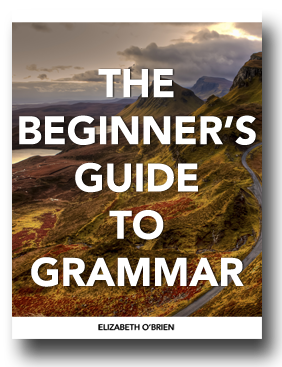Download your free grammar guide here.
Download your free grammar guide here.
Proper Nouns & Common Nouns
Proper Nouns & Common Nouns
- Home
- Parts of Speech
- Nouns
- Common & Proper Nouns
It's time to learn about proper nouns and common nouns. Are you ready? Great!
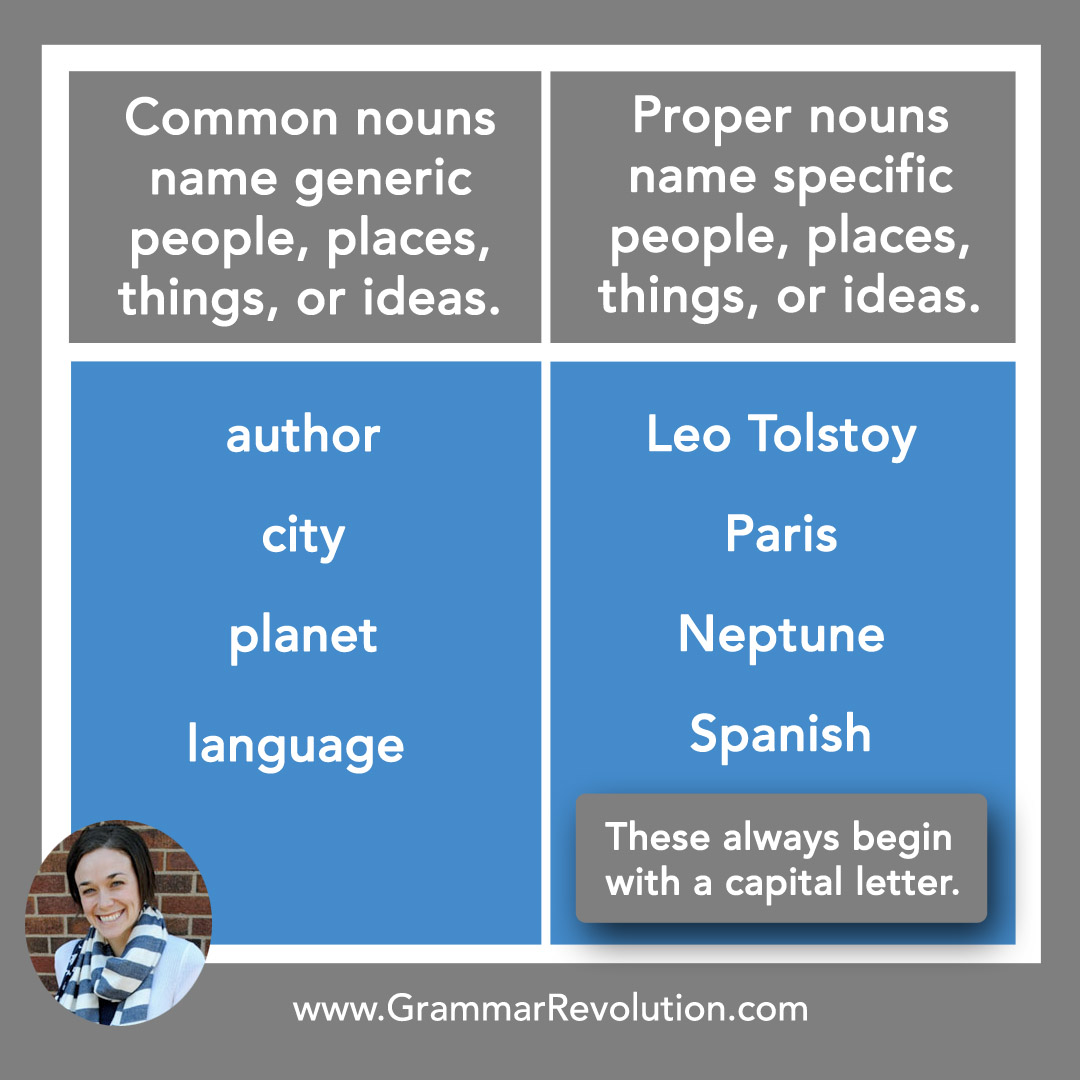
You probably already know what a noun is, but I'm still going to give you a little refresher. :) Nouns are words that name people, places, things, or ideas. There are many different types of nouns, and in this lesson, we'll go over two of them: common and proper.
Learning about common nouns will help you understand proper nouns, so let's focus on common nouns first, and then we'll see what the relationship is between them.
What are common nouns?
Common nouns are usually the first words that we learn when we learn a new language, so they're pretty important! They name people, places, things or ideas that are generic/general.
woman, city, dog
Notice that we don't know exactly which woman, city, or dog we're referring to. That's because these words are general rather than specific. (Think of these as opposed to proper nouns in those categories, which would name a specific woman, city, and dog. Examples of proper nouns for these categories would be Elizabeth, Chicago, and Rex.) Let's go over some of the important points to know about common nouns.
- Lowercase: Since these nouns aren't naming anything specific, they don't need to start with a capital letter unless they begin a sentence.
- Broad Categories: Common nouns represent broad categories of things. They are used to talk about things in a general sense rather than in a specific sense. For example, bird is a common noun that includes various species like sparrows, eagles, and robins.
- Articles and Determiners: Common nouns are often accompanied by articles (a, an, and the) or other determiners (some, many, etc.).
Common nouns really are the building blocks of language! Now, let's focus on proper nouns...
What are proper nouns?
These are nouns that name specific people, places, things, or ideas.
Maya, Paris, Rover
Do you see how these are different? Maya is naming a specific woman, Paris is naming a specific city, and Rover is naming a specific dog. Let's go over some of the important things to know about proper nouns!
- Capitalization: Proper nouns are always capitalized, regardless of their position within a sentence. This capitalization helps signal that the noun is a specific name or title, setting it apart from common nouns.
- Capitalizing Compound Nouns: Sometimes, proper nouns contain two or more words.
Maya Angelou, Central Park Zoo, the Gulf of Mexico
If this is the case, the important words are capitalized, and the whole thing is still considered to be one noun even though it's made up of more than one word. Don't capitalize small words like of and the.
- Names and Titles: Proper nouns include personal names (John Smith), geographical names (Mount Everest), brand names (Coca-Cola), and titles (President).
- Context Needed: Proper nouns often require some context for full comprehension. People may need to know the background or context of a proper noun to understand its significance. For example, if you tell your friend that you're going to Paris, she would need to know that Paris is a city in order to understand what you were telling her.
- Articles: Singular proper nouns usually don't use articles (David, Chicago).
- Proper Adjectives: Proper adjectives are formed from proper nouns (Mexico --> Mexican).
Now let's look at how common nouns and proper nouns are related to each other, shall we?
What is their relationship?
Every proper noun has a common noun equivalent.
Proper --> Common
Kleenex --> tissue
Honda Odyssey --> van
V8 --> juice
However, not every common noun has a proper noun equivalent.
Common --> Proper
hand --> -
dirt --> -
space --> -
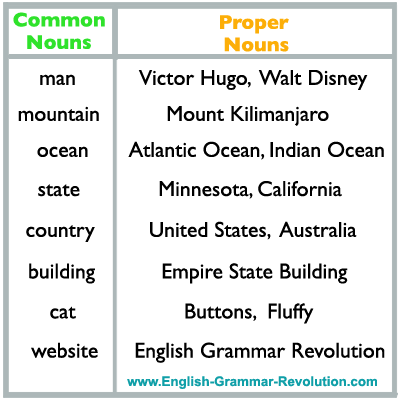
What Can They Do?
Both of these kinds of nouns can perform many jobs in sentences. Below, you'll find five noun jobs. (All of the nouns in these example sentences are common.)
These examples also include sentence diagrams. Sentence diagrams are pictures of sentences that basically make the grammar in the sentence visual. That sounds kind of strange, but it's true. Figuring out a sentence's diagrams is like solving a puzzle. Diagrams are a great way to learn grammar!
1. Subject The students happily studied grammar.
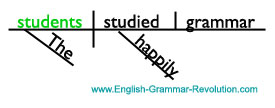
2. Direct Object The students happily studied grammar.

3. Indirect Object They taught their friends grammar.
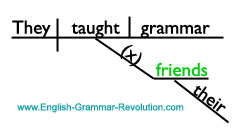
4. Object of the Preposition Their friends smiled with glee.
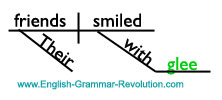
5. Predicate Nominative They were grammar champions!
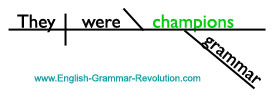
Tiny Quiz
Instructions: Decide whether the underlined word is a common noun or a proper noun.
- What is your favorite book to read at bedtime?
- The Amazon River flows through the heart of the rainforest.
- Have you ever visited the city of Rome?
- The team celebrated their victory with a parade.
- My aunt is an excellent cook; she made a delicious cake.
- The Eiffel Tower is a famous landmark in France.
- We studied ancient civilizations in history class.
- John loves to play the piano in his free time.
- The company's headquarters are located in New York City.
- Shakespeare's plays are still performed on stages around the world.
Answers:
- common noun (book)
- proper noun (Amazon River)
- proper noun (Rome)
- common noun (team)
- common noun (aunt)
- proper noun (Eiffel Tower)
- common noun (civilizations)
- common noun (piano)
- proper noun (New York City)
- This is kind of a trick question! Shakespeare's is a proper adjective. It's formed from the proper noun Shakespeare. :)
Summary
How did that go? Do you feel like you have a good handle on these types of nouns? Let's review what we covered on this page.
- Common nouns name general people, places, things, or ideas.
- Proper nouns name specific people, places, things, or ideas.
- While every proper noun has a corresponding common noun, not every common noun has a corresponding proper noun.
- Common nouns and proper nouns can do many things in sentences. They can be subjects, objects, predicate nouns, and more.
- Sentence diagramming is fun and helps us see what each word in a sentence is doing. :)

Hello! I'm Elizabeth O'Brien, and my goal is to get you jazzed about grammar.
Thank you for your website. It helps solidify my attempts at getting my students thrilled about proper grammar!
- Marie, Teacher
If you'd like to teach or learn grammar the easy way—with sentence diagrams—check out our Get Smart Grammar Program.
It starts from the very beginning and teaches you grammar and sentence diagramming in easy, bite-size lessons.
This is original content from https://www.english-grammar-revolution.com/proper-nouns.html
Our Free Guide Gives You A Fun Way
To Teach And Learn The Basics v

Elizabeth O'Brien is the creator of Grammar Revolution.
Her lessons are guaranteed to give you more confidence in your communication skills and make you smile. :)
Other Helpful Resources

